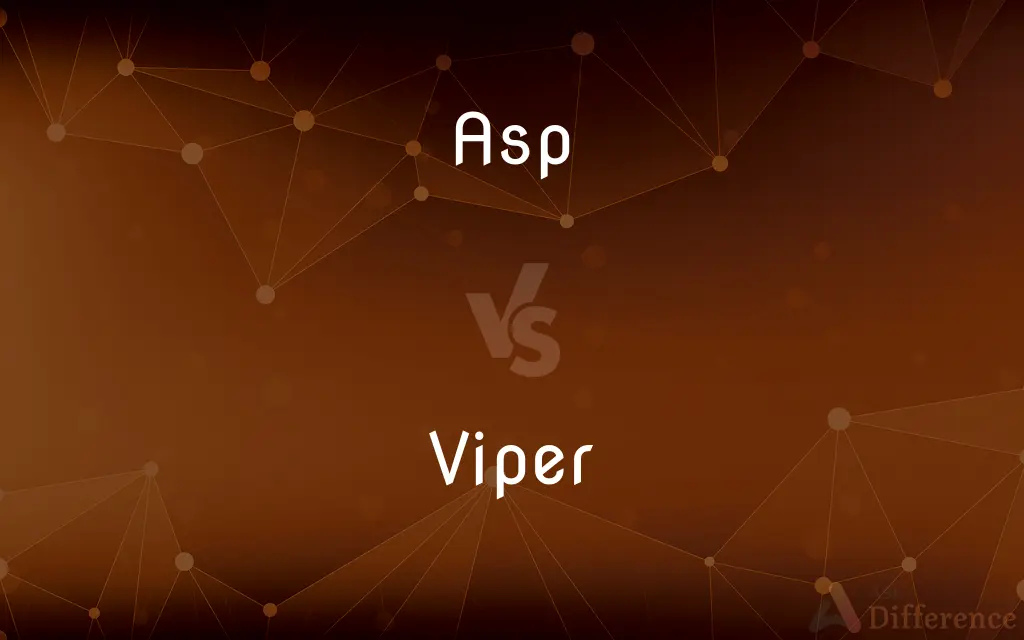Asp vs. Viper — What's the Difference?
By Tayyaba Rehman & Maham Liaqat — Updated on March 29, 2024
Asp usually refers to several venomous snake species, historically linked to the Egyptian cobra, while viper is a broader term for a family of venomous snakes known for their long, hinged fangs and striking ability.

Difference Between Asp and Viper
Table of Contents
ADVERTISEMENT
Key Differences
The term "asp" historically refers to venomous snakes that were notorious in ancient times, especially in Egypt, with the Egyptian cobra being one of the most famous examples. The asp gained infamy through stories, notably that of Cleopatra's suicide. Today, "asp" can be used to describe various venomous snakes across different regions, not confined to a single species. It is more of a historical or common name rather than a specific classification in herpetology.
Vipers, on the other hand, belong to the Viperidae family, characterized by their distinctive long, hinged fangs which allow for an efficient venom delivery system. This family includes several genera and species, such as rattlesnakes, pit vipers, and the true vipers, which are found worldwide. Vipers are known for their ability to strike quickly and inject venom into their prey or in defense against threats.
One of the key distinctions between asps and vipers lies in their taxonomy and venom delivery mechanisms. While "asp" is a more generic term that could refer to any of several venomous snakes with varying venom delivery methods, vipers have a specialized system with their hinged fangs. This adaptation allows vipers to bite and inject venom deeply, making them particularly efficient predators and formidable when threatened.
Habitat and geographical distribution also differentiate asps from vipers. Asps, such as the Egyptian cobra, are primarily associated with Africa and the Middle East. In contrast, vipers have a broader distribution, inhabiting various ecosystems across the world, from the Americas to Eurasia and Africa. This global presence underscores the adaptability and ecological diversity of the Viperidae family.
Public perception and cultural significance of asps and vipers vary greatly due to historical and mythological influences. The asp is often associated with ancient Egypt and its lore, embodying mystery, danger, and the exotic. Vipers, with their widespread presence, have infiltrated folklore and mythology in many cultures, symbolizing danger, deceit, or healing, depending on the context.
ADVERTISEMENT
Comparison Chart
Definition
A term historically referring to venomous snakes, notably the Egyptian cobra
A family of venomous snakes with long, hinged fangs
Taxonomy
Not a specific classification; refers to various snakes
Viperidae family, including several genera and species
Venom Delivery
Depends on the species; not all have specialized fangs
Long, hinged fangs that allow for efficient venom injection
Habitat
Primarily Africa and the Middle East
Worldwide distribution, in diverse ecosystems
Cultural Significance
Associated with ancient Egypt and mythology
Symbolizes danger and deceit, but varies by culture
Compare with Definitions
Asp
Can refer to various venomous snakes.
In different regions, the term asp might refer to different species.
Viper
Known for striking ability.
Vipers can strike quickly to inject venom into their prey or threats.
Asp
Linked to ancient lore.
Asps are often mentioned in historical and mythological contexts.
Viper
A family of venomous snakes with hinged fangs.
Vipers are capable of a rapid and deep venom injection.
Asp
Historically, a venomous snake associated with Egypt.
The asp is famously linked to Cleopatra’s death.
Viper
Found in diverse habitats worldwide.
Vipers inhabit forests, deserts, and mountains across the globe.
Asp
Not a taxonomic term.
Asp is more of a common name than a scientific classification.
Viper
Includes rattlesnakes and pit vipers.
The rattlesnake is a well-known type of viper in North America.
Asp
Any of several venomous snakes, especially the viper Vipera aspis of southern Europe, the cobra Naja haje of Africa and the Middle East, or the horned viper.
Viper
Subject of fear and respect.
Vipers have a formidable reputation due to their venomous bite.
Asp
(archaic) A water snake.
Viper
Any of various venomous snakes of the family Viperidae, having a thick heavy body and a single pair of long hollow fangs, especially the Eurasian and African species of the subfamily Viperinae, which lack the sensory pits of the pit vipers.
Asp
A venomous viper native to southwestern Europe (Vipera aspis).
Viper
Any of several harmless snakes sometimes believed to be venomous.
Asp
The Egyptian cobra (Naja haje).
Viper
A person regarded as malicious or treacherous.
Asp
(figurative) An evil person; a snake.
Viper
A venomous snake in the family Viperidae.
Asp
A type of European fish (Aspius aspius).
Viper
(informal) Any venomous snake.
Asp
The aspen tree.
Viper
(figurative) A dangerous, treacherous, or malignant person.
Asp
Same as Aspen.
Viper
(slang) A person who smokes marijuana.
Asp
A small, hooded, poisonous serpent of Egypt and adjacent countries, whose bite is often fatal. It is the Naja haje. The name is also applied to other poisonous serpents, esp. to Vipera aspis of southern Europe. See Haje.
Viper
Any one of numerous species of Old World venomous snakes belonging to Vipera, Clotho, Daboia, and other genera of the family Viperidæ.
There came a viper out of the heat, and fastened on his hand.
Asp
A thorny shrub yielding a fragrant oil.
Viper
A dangerous, treacherous, or malignant person.
Who committedTo such a viper his most sacred trustOf secrecy.
Asp
Of southern Europe; similar to but smaller than the adder
Viper
Loosely, any venomous or presumed venomous snake.
Asp
Cobra used by the Pharaohs as a symbol of their power over life and death
Viper
Venomous Old World snakes characterized by hollow venom-conducting fangs in the upper jaw
Common Curiosities
Has the asp been misrepresented in history?
The asp’s depiction, especially in stories like Cleopatra’s death, may blend historical fact with mythology, leading to some misrepresentations.
Are all vipers equally venomous?
Venom potency varies among viper species, with some being more dangerous to humans than others.
What is the main difference between an asp and a viper?
The main difference is that "asp" refers to specific venomous snakes, often historically, while "viper" describes a family of snakes known for their venom delivery system.
Can asps be found outside of Egypt?
Yes, the term "asp" can refer to various venomous snakes in different regions, not limited to Egypt.
What cultural significance do vipers hold?
Vipers appear in folklore and mythology worldwide, often symbolizing danger, transformation, or healing, depending on the culture.
Why are vipers considered efficient predators?
Their long, hinged fangs and ability to inject venom deeply make vipers efficient at subduing prey quickly.
How do humans impact the populations of asps and vipers?
Habitat destruction, pollution, and persecution due to fear negatively impact the populations of these snakes.
Is the Egyptian cobra the only snake referred to as an asp?
While the Egyptian cobra is the most famous, the term "asp" has been used for several venomous snakes across history.
Are there any non-venomous snakes that resemble vipers?
Yes, some non-venomous snakes mimic the appearance of vipers as a defense mechanism against predators.
Can the venom of vipers be used for medical purposes?
Yes, research into viper venom has contributed to the development of medications, including anticoagulants and pain relievers.
How do vipers contribute to their ecosystems?
Vipers control rodent populations and other pests, playing a crucial role in maintaining ecological balance.
What makes vipers unique among snakes?
Vipers are unique due to their specialized venom delivery system, which includes long, hinged fangs for efficient venom injection.
Share Your Discovery

Previous Comparison
Magical vs. Whimsical
Next Comparison
Ya vs. JaAuthor Spotlight
Written by
Tayyaba RehmanTayyaba Rehman is a distinguished writer, currently serving as a primary contributor to askdifference.com. As a researcher in semantics and etymology, Tayyaba's passion for the complexity of languages and their distinctions has found a perfect home on the platform. Tayyaba delves into the intricacies of language, distinguishing between commonly confused words and phrases, thereby providing clarity for readers worldwide.
Co-written by
Maham Liaqat












































